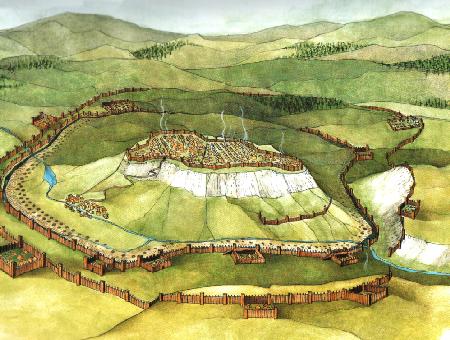Julius Caesar and Gaul
|
Share This Page
|
|
|
|
|
|
|
Follow This Site

|
 |
|
|
Part 2: Victory for Rome
 Come Caesar did, and history was made in one of the most extraordinary sieges in the annals of world military history.
Come Caesar did, and history was made in one of the most extraordinary sieges in the annals of world military history.
Vercingetorix had an army of 80,000 ensconced on the hillside, many of whom were involved in the construction of extensive defensive fortifications. The defensive position of the Gauls was so good, in fact, that it earned high praise from Caesar himself. Writing in his Commentaries or Gallic Wars, he had this to say:
"It was clearly impregnable except by blockade; for it stood at a high altitude on top of a hill washed by streams on the north and south, and closely surrounded by other hills as high as itself on every side except the west, where a plain extended for some three miles. The whole of the slope below the town ramparts on the east was occupied by a camp crowded with Gallic troops, who had fortified it with a trench and a six-foot wall. The siege works that the Romans were starting to make had a circumference of ten miles. Eight camps were placed in strategic positions, linked together by fortifications along which twenty-three redoubts were built. The redoubts were occupied in the daytime by pickets, to prevent a surprise attack at any point; at night strong garrisons bivouacked in them with sentries on duty."
Faced with this daunting obstacle, Caesar pressed on and eventually won the battle. It wasn't easy, however.
The Gauls had six men for every one that Caesar had. Vercingetorix had 80,000 men in his hilltop citadel. Another huge Gallic army, numbering 300,000, was on its way. Caesar had no choice to defend himself. What he created was one of the most breathtaking, original, and enormously practical and efficient series of fortifications ever invented.
One series of walls stretched a total of 10 miles. A ditch stretching 18 feet wide was protected by a second trench, filled with water. Next was a series of buried iron "mantraps," holes in the ground that stretched several fee into the earth and contained pointed stakes that would impale anyone unlucky enough to fall in. After that was a third wall, nine feet high and populated with square towers containing siege equipment.
This was the fortification system designed against Vercingetorix. But Caesar wasn't done.
Knowing that another Gallic force was on the way, he had built another series of fortifications, this one 13 miles long, to keep the "rescuing" Gallic army from reaching Alesia. In the middle of all this were Caesar and his legions. The Romans couldn't go anywhere, but the Gauls couldn't get in or out.
Not being a stupid battle commander, Vercingetorix tried his best to keep these fortifications from being built. He sent wave after wave of fierce troops out to harass the Roman engineers, but the famed Roman discipline held and repulsed these attacks. The construction continued and was eventually completed.

Weeks went by, with skirmishes here and there. Each commander was trying to outwait and outwit the other. Vercingetorix had a large horde of people (men, women, and children) that he had to feed. Many of these people were hungry already. Caesar had a much smaller force made up of just soldiers. The Gauls definitely had the worse of it as far as supplies, and they were surrounded by a Roman army that had no intention of letting reinforcement supplies get through.
Impatient and hungry, the Gauls threw themselves at the Roman fortifications but not could break through. Amazingly, outnumbered 6-to-1, the Romans won the battle. Vercingetorix surrendered, and the land of Gaul was absorbed into the Roman territories, soon to be Empire.
First page > Clash of the Titans > Page 1, 2



 Come Caesar did, and history was made in one of the most extraordinary sieges in the annals of world military history.
Come Caesar did, and history was made in one of the most extraordinary sieges in the annals of world military history.

